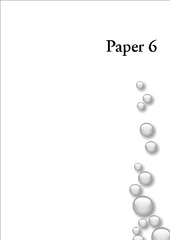| dc.contributor.author | Kristiansen, Trond | eng |
| dc.date.accessioned | 2007-03-28T09:00:32Z | |
| dc.date.available | 2007-03-28T09:00:32Z | |
| dc.date.issued | 2007-03-02 | eng |
| dc.identifier.isbn | 978-82-308-0333-2 (print version) | en_US |
| dc.identifier.uri | http://hdl.handle.net/1956/2190 | |
| dc.description.abstract | Newly hatched Atlantic cod (Gadus morhua) larvae face an uncertain future when they first enter their marine pelagic habitat. Prior to complete yolk absorption, the larvae will have to find food. This process includes the visual encounter, pursuit and attack, and capture and digestion of the prey item for utilization to meet energetic demands for metabolism and growth. However, food is not always easy to find and it is essential for larval survival that they encounter habitats where prey are abundant, and that the prey are of edible size. Fast growth ensures short time as small vulnerable larvae in a marine habitat consisting of numerous predators. This thesis emphasizes the use of individual-based models to explore and understand the various mechanisms that determine successful growth and survival through the early pelagic life stages of cod (Gadus morhua). We model larval feeding, growth, behavior, and survival, under various environmental settings at the spawning and nursery grounds along the coast of northern Norway and at Georges Bank located on the eastern coast of USA. Paper 1 focuses on the assemblage of a mechanistic individual-based model (IBM) for larval and early juvenile cod, and the validation of the model by comparing observed and modeled data. Validation and forcing data consisted of biological and environmental data from a controlled environment (macrocosm). Larval cod are able to move up and down in the water column in a prescribed manner by following rules of behavior. Vertical behavior elevates larval growth rates, compared to growth achieved under random behavior. Maximum growth rates are achieved for larvae in environments where prey density exceeded 10 nauplii·L-1. The implementation of vertical behavior in IBMs of larval fish was elaborated in Paper 2. Strong gradients in pelagic horizontal currents create different dispersal patterns of larval fish at different depths. This will in turn have strong effects on the integrated survival, growth, and dispersal of larval fish. Adaptive traits differ between individuals, are subject to selection, and have implications for the life history success of individuals, and emergent properties at the population level. Adaptive behavior in coupled IBMs and general ocean models can have significant impact on our understanding of life history traits of fish. In Paper 3 we test various strategies for vertical behavioral in IBMs. We implemented vertical behavior as a property that emerges from the trade off between individual state (stomach fullness and size) and the local environment (prey and predators). A number of strategies were tested and all proved to increase survival probability drastically compared to individuals that moved randomly. By implementing the vertical behavior as described in Paper 3 in an IBM, we are able to compare observations, and modeled feeding of cod larvae on zooplankton on Georges Bank, as described in Paper 4. The model predicts Pseudocalanus spp. to be the main prey item for larval cod because of its visibility of in the water column and its abundance. The preference for Pseudocalanus agrees with stomach observations. The model also predicts Centropages to be an important prey item. However, with the exception of nauplii stages, Centropages is seldom found in stomach samples. Centropages may be inaccessible as a prey item because of their behavior or morphology. In Paper 5 we couple an IBM with a three-dimensional ocean model (ROMS). Individual larval cod are allowed to migrate vertically following simple rules while being advected horizontally by the simulated currents. Larvae that differ in behavioral strategy are released at two major spawning grounds of Northeast Arctic cod, Vestfjorden and Moskenesgrunnen in Northern Norway (68ºN) and tracked until size 18 mm. Behavior increased larval probability of survival compared to larvae passively drifting at fixed depths. Behavior influenced both the local depth distribution and the long-term horizontal distribution of larvae. The coupled biophysical model is used in Paper 6 to explore the effect of light, prey density, temperature, and turbulence on larval growth of Northeast Arctic cod through the spawning season. Light has a severe impact on growth of small (5-7mm) larvae. Prior to mid April, larval growth is low because of the limited hours of light sufficient for feeding. After mid-April, the increase in day length enables high growth rates for both 5 and 7mm larvae as long as prey density exceeds 5 nauplii·L-1. This suggests that peak spawning time of Northeast Arctic cod occurs when light conditions are optimal for larval feeding and growth. This thesis advocates the use of adaptive behavior as part of individual-based models for understanding the mechanisms that drive the dynamics and interactions between the ecosystem and its inhabitants. An IBM represents a practical and reliable tool to bridge the gap between physical oceanography and biology across a wide range of scales. Observations of the biological and physical structure of ecosystems provide data necessary for model validation, a requirement for making general ecological conclusions based on model results. In light of my work, I believe that this approach can reveal new information of life history traits of individuals and their consequences on population level, thereby increasing our understanding of ecosystems. | en_US |
| dc.format.extent | 1443414 bytes | eng |
| dc.format.extent | 4733906 bytes | eng |
| dc.format.extent | 1118605 bytes | eng |
| dc.format.extent | 2614226 bytes | eng |
| dc.format.extent | 5163801 bytes | eng |
| dc.format.extent | 3501356 bytes | eng |
| dc.format.extent | 5745455 bytes | eng |
| dc.format.mimetype | application/pdf | eng |
| dc.format.mimetype | application/pdf | eng |
| dc.format.mimetype | application/pdf | eng |
| dc.format.mimetype | application/pdf | eng |
| dc.format.mimetype | application/pdf | eng |
| dc.format.mimetype | application/pdf | eng |
| dc.format.mimetype | application/pdf | eng |
| dc.language.iso | eng | eng |
| dc.publisher | The University of Bergen | en_US |
| dc.relation.haspart | Paper I: Canadian Journal of Fisheries and Aquatic Sciences 64(1), Trond Kristiansen, Øyvind Fiksen, and Arild Folkvord, Modelling feeding, growth and habitat selection in larval cod (Gadus morhua) : observations and model predictions in a macrocosm environment, pp. 136-151. Submitted version. Copyright 2007 NRC Press. | en_US |
| dc.relation.haspart | Paper II: Øyvind Fiksen, Christian Jørgensen, Trond Kristiansen, Frode Vikebø, and Geir Huse, Linking behavioural ecology and oceanography: larval behaviour determines growth, mortality, and dispersal. Preprint. Accepted for publication in Marine Ecology Progress Series. Published by Inter-Research. | en_US |
| dc.relation.haspart | Paper III: Trond Kristiansen, Christian Jørgensen, R. Gregory Lough, Frode Vikebø, and Øyvind Fiksen, Trading risk and growth: exploring behavioral rules of larval cod on Georges Bank. Submitted version | en_US |
| dc.relation.haspart | Paper IV: Trond Kristiansen, R. Gregory Lough, Francisco E. Werner, Elisabeth Broughton, and Larry J. Buckley, Modeling prey selection and growth of larval cod on Georges Bank. Submitted version | en_US |
| dc.relation.haspart | Paper V: Frode Vikebø, Christian Jørgensen, Trond Kristiansen, and Øyvind Fiksen, Drift, growth and survival of larval Northeast Arctic cod with simple rules of behaviour. Preprint. Accepted for publication in Marine Ecology Progress Series. Published by Inter-Research. | en_US |
| dc.relation.haspart | Paper VI: Trond Kristiansen, Frode Vikebø, Svein Sundby, Geir Huse, and Øyvind Fiksen, Growth and feeding of larval cod (Gadus morhua) in large-scale latitudinal environmental gradients. Submitted version | en_US |
| dc.title | Modeling early life history of cod | en_US |
| dc.type | Doctoral thesis | |
| dc.subject.nsi | VDP::Matematikk og Naturvitenskap: 400::Basale biofag: 470 | nob |






